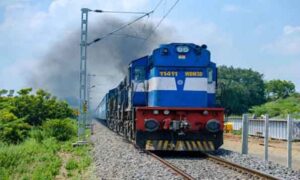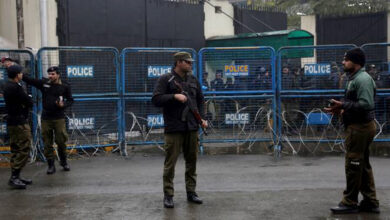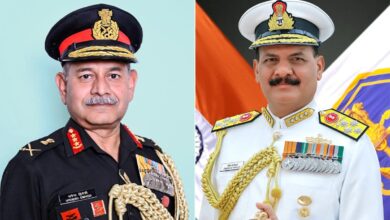Bangladesh-India Transit: Trial train may start this month
A new transit route between Bangladesh and India is likely to start trial trains this month. The new route will enter Bangladesh through Chuadanga Darshan, Pabna’s Ishwardi, Natore’s Abdulpur, Dinajpur’s Parvatipur, Nilphamari’s Chilahati and will reach Cooch Behar in West Bengal, India. The map of this new route will be submitted by India to the Ministry of Railways of Bangladesh on Monday. During Prime Minister Sheikh Hasina’s recent visit to India, a memorandum of understanding was signed between the two countries to launch this new rail transit. The implementation of this memorandum has already started. News from related sources.
Prime Minister Sheikh Hasina paid a bilateral visit to India on June 21 and 22. His visit was held at the invitation of Indian Prime Minister Narendra Modi. During the visit, 10 MoUs were signed between the two countries. One of these MoUs is the new MoU on Rail Transit. During the visit, the Prime Ministers of the two countries announced a ‘Shared Vision’. It is mentioned that India will facilitate the delivery of Bangladeshi products to Nepal and Bhutan by rail. Before independence, there were passenger and freight medium trains between Bangladesh (now East Pakistan) and India. In 1965, due to Indo-Pak War, rail communication was stopped. Now trying to re-establish those connections. There are 9 interchange points for connecting Indian Railways with Bangladesh Railways. Six of them are currently operational. Currently three passenger trains run between Bangladesh and India through these interchange points. Freight trains also run between the two countries.
Maitri Express train runs from Dhaka to Kolkata via Darshana-Gede interchange point. Bandhan Express runs from Khulna to Kolkata via Benapole-Petrapole Interchange. And Mithali Express train runs from Dhaka Cantonment Station to New Jalpaiguri through Chilahati-Haldibari Interchange Point. Apart from these three passenger trains, regular freight trains run through various interchange points. However, the new rail transit that is being launched this time will enter Bangladesh through one interchange point and go back to India through another interchange. Although this type of transit is new, railway officials in Dhaka say that Bangladesh will benefit economically due to the new transit.
In this regard, the secretary of the Ministry of Railways on Saturday afternoon. Humayun Kabir said that the memorandum of understanding between the two countries on the issue of train movement between the two countries has been signed at the level of the Prime Ministers of the two countries – if it is implemented, there will be radical changes in Bangladesh Railways. Bangladesh Railway will benefit more economically. Indian Railway Advisor met me. Today Monday (July 1) they will provide us with a route map. Accordingly, we will have a special meeting in coordination with the Ministry of Railways and the relevant ministries. The decision of the meeting will be given at the field level. After that, within the next few weeks i.e. by the month of July, India will be able to run the test train. Dr. Humayun Kabir also said that even now passenger and freight trains are running between the two countries. Bangladesh Railway is collecting the most revenue from these trains. At the same time, if India runs direct trains using Bangladesh railways, as the income will increase, India will also cooperate more in the development of railways. According to the new proposal, the train will run from Haldibari to Dalgaon station on the Bhutan border. As a result, Haldibari-Chilahati route will be connected from Gede-Darshana border. Meanwhile, a memorandum of understanding has been signed between the two countries to start the train from Rajshahi to West Bengal’s Kolkata route, added Dr. Humayun Kabir.
Transit over Bangladesh is very important for connecting the seven northeastern states of India with the rest of the country. There is no direct link between the two parts except for a 20 km long corridor called the Siliguri Corridor. This route has road and rail connectivity between the two parts of India. The corridor is popularly known as ‘Chicken’s Neck’ as it looks like a chicken’s neck. Bangladesh, Nepal and Bhutan are located along this corridor. The Chinese border is not too far. As a result, there is a risk that India’s relationship with China will be vulnerable in a conflict situation. As a result, transit over Bangladesh is convenient. India is also trying to open transit through the Kaladan River in Myanmar to connect the two parts. Due to the conflict situation in Myanmar, the work of the project is temporarily stopped.
According to the related sources, the new transit package will also be profitable for Bangladesh. Because India will provide rail transit facility to take the products of Bangladesh to Nepal and India. Besides, as per the MoU, the railway line from India’s Haldibari will go to Dalgaon, a station on the border with Bhutan.
The MoU was not disclosed by either side, Bangladesh and India. However, officials say that the new transit tariff will be reviewed by the Ministry of Commerce and the National Board of Revenue and the Ministry of Security.
Ministry of Railways sources say that the proposal of India recently Railway Secretary Dr. India’s proposals also came up in the meeting chaired by Humayun Kabir. In the meeting, it initially emerged that the route of the Indian train would be through Bangladesh’s Darsana-Chilahati to India’s Haldibari-Jalpaiguri-Dhupaguri-Falakata-Dangaon-Jaipur to Hasimara station near the Bhutan border. The Bhutan border is 108 km away from where India wants to run trains up to Dalgaon station. After Dalgaon Jaipur and Hasimara stations. Distance from Hasimara to Indo-Bhutan land port Fuent Shillong is 18 km. According to Rail Bhawan in Dhaka, if the train reaches Hasimara, Bangladesh will be able to increase trade with Bhutan over India.
Director General of Railways Sardar Shahadat Ali said, ‘Two freight trains are running between the two countries. Both trains are from India. Bangladeshi goods are going to Nepal through Indian territory via Rohanpur in Chapainawabganj, Bangladesh by that train. According to the new proposal, Bangladesh Railway is getting another route to Nepal. Now earning around 200 crores per financial year from two cargo trains. If more trains run using Bangladesh Railways, the revenue will increase by 3 to 4 times more. According to the proposal, a proposal was already made by the Indian High Commission to run a train experimentally from Gede-Darshana-Ishwardi-Abdulpur-Parbatipur-Chilahati-Haldibari-Dalgaon. Sardar Shahadat Ali also said that Bangladesh Railway is earning the most revenue from the number of passenger and cargo trains currently running between the two countries. If Indian trains run directly through Bangladesh again or if more trains are added to the previous rules, there will be radical changes in the development of Bangladesh Railways. During the British era, there were 8 interchanges in present India-Bangladesh. The interchanges were Darshana-Gede, Benapole-Petrapole, Rohanpur-Singhabad, Birol-Radhikapur, Shahbazpur-Mahisasan, Chilahati-Haldibari, Burimari-Changrabandha and Mughalhat-Gitaldah. At least 15 trains used to run through the interchanges. At present Bangladesh-India trains run on five routes.





